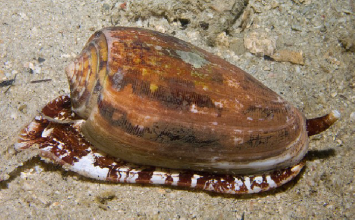 The Cone snail is a marine mollusc that can be found in tropical and subtropical waters around the world. These snails have a unique cone-shaped shell, and vary in size, with some species reaching up to 23 centimetres in length. Cone snails are known for their venomous harpoons, called radula, which they use to immobilize and capture their prey, mainly fish and other snails.  A cone snail's teeth are located inside the snail's throat, on the radula. The radula is a ribbon-like structure that contains many microscopic teeth, which are used to scrape food. Cone snails also have specialized teeth in their proboscis that are hollow and barbed, and are used to deliver venom to their prey. Cone snails extend the proboscis and use a radula tooth within it to sting. The radula tooth is hollow, barbed, and loaded with venom.
A cone snail's teeth are located inside the snail's throat, on the radula. The radula is a ribbon-like structure that contains many microscopic teeth, which are used to scrape food. Cone snails also have specialized teeth in their proboscis that are hollow and barbed, and are used to deliver venom to their prey. Cone snails extend the proboscis and use a radula tooth within it to sting. The radula tooth is hollow, barbed, and loaded with venom.The tooth is fired into the prey with a muscular contraction, similar to a bullet being fired from a gun. After envenomating the prey, the cone snail retracts the radula from the proboscs and draws the prey into its mouth through the proboscis, which expands.  Of the five hundred species of venomous Cone snails, just a few are dangerous enough to kill you. Conus geographus is the most deadly variety, and is considered the most dangerous creature on earth.
Of the five hundred species of venomous Cone snails, just a few are dangerous enough to kill you. Conus geographus is the most deadly variety, and is considered the most dangerous creature on earth. It has more than one hundred toxins in its small, fifteen centimetre body. Cone venom is a complex mixture of compounds that cause paralysis through neuromuscular blocking, and has no antidote. The venom is highly toxic, and although it can be deadly to humans, it is also being studied for potential medical uses. Scientists have found one component from the venom of Cone snails which is more potent than morphine. There are potentially over 250,000 different compounds, any of which could have the potential to become valuable medicines. Cone snails don't exhibit territorial behavior or engage in fights with other animals or other Cone snails. They are solitary creatures that spend their time hunting for food. Cone snails are also remarkable for their ability to hunt by sensing prey vibrations in the water. They have a specialized sensory structure called a siphon, which can detect even the slightest movements of potential prey. Adult Cone snails don't have many natural predators due to their venomous defense, but some crabs and a few specialized predators are known to prey on Cone snail eggs and young snails. creatures on the Dangerous Animals of Australia page. |